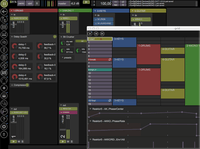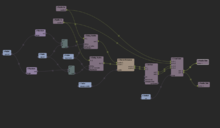Usine
 Sensomusic Usine ( version Hollyhock) | |
| Developer(s) | Sensomusic |
|---|---|
| Stable release | 1.02 / July 2, 2013 |
| Written in | Borland Delphi |
| Operating system | Mac OS X and Microsoft Windows |
| Type | Digital Audio Workstation, Audio programming language |
| Website | |
Sensomusic Usine now, in Hollyhock version is a Multitouch digital audio workstation used to manipulate, record and edit audio and MIDI in live situations. Usine is developed in Delphi by the French double bass player Olivier Sens, running on Mac OS X and Microsoft Windows.
The purpose of this software is to change a sound as it is being played in a loop. This software allows you to edit the sounds, instruments, or drum beats as they are being played back through the speakers. The ability to loop and edit sound in real time is very similar to the function of loop pedals. Loop pedals are under the artist’s feet. When they record something like a guitar riff, the artist can stomp on the pedal to make that riff a loop. They do that for each new sound they layer into the piece, until a full piece of music is formed. More recently, Usine has been modified to be usable on a touch screen laptop, which makes it easier to use.
Usine is often used to create Glitch music, which is based on sound effects and the random use of sounds. Usine's ability to change sounds immediately, loop them, and make a whole new melody makes it a great tool for artists looping their sound samples. There are many artists that use Usine with other programs in their live or studio audio setups. A glitch artist named Bartelby of Pance Party used Usine on a touchscreen to perform his electronic music piece “Morgasm”. Another artist named Paul Brousseau has used Usine to mix some of the 12 music albums he has worked on.
Usine exists in free and pro versions.



Overview
- Process sound modularly: create patches with modules and connect them by virtual wires .
- Analyse input or generated sound, for example pitch, peaks or dynamics to create adaptive effects which can modify any parameter in real time.
- Organize patches, sounds, and effects on a timeline with the sequencer mode. Create complex automation curves.
- Use the built-in virtual mixing table to mix the sound produced by different patches on each track (unlimited).
- Manage 64 external audio sources and apply different effects to any of them.
- Create flexible Surround projects: all audio tracks are natively 16.0. The output sound can be routed to any of the 64 available outputs, depending on the sound card.
- Capability to share patches from a computer to another on a local network. A shared patch can appear on all (or a restricted list) connected computers. Then it becomes a simple remote of the original (called master) one.As well, synchro informations (like tempo, start, etc.) can be sent automatically to all remotes to maintain the computers synchronized.Moreover MIDI devices can send data’s all over the network. So you can use a MIDI device connected to a computer to modify parameters of another computer.
- Create insert patches on any input or output channel. For example a master limiter or a master reverb.
- Complete VST processing: Use any VST or AU instrument or effect in patches and modify any Plug-in Parameter in real time. Create simple front-end interfaces for your plug-in.
- Complete MIDI automation: assign any Usine visual object to a midi controller with midi-learn command. Complete integration of motorized external controllers.
- Complete MIDI input/output management for Plug-in instruments or external expanders.
- Load up your patches in memory in a grid and activate them in real time.
- Synchronize patches and plug-ins with a master tempo.
- Record creations directly on the hard disk in real time: separate tracks, inputs and outputs.
- All Usine functions are real-time, resample, modify, input sound on the fly.
- Save patches, complete setups, and configurations, for adaptation to different projects.
- Unlimited Undo/Redo.
- Use any sample rate supported by an Asio sound card. Usine has a 32 bit floating-point audio engine.
- Unlimited number of internal Audio, Data and Midi buses.
- Pascal-like scripting capabilities which allow for the creation of new audio and midi processing modules.
- Full Open Sound Control (OSC) compatibility to communicate with other computers connected to the network or Internet.
- C++ programmers can create new graphic and control modules using the SDK.
- Use the video tracker to modify sound parameters with a camera.
- Play videos and synchronize audio.
- Usine is fully touch and multi-touch enabled.
- Integration of the Leap Motion module, Arduino interface and Wiimote
References
- Kirn, Peter. "Sensomusic Hollyhock: An Open-Ended, Modular DAW from Usine Makers, Now Mac + Windows [Beta Preview]".http://createdigitalmusic.com/2012/12/sensomusic-hollyhock-an-open-ended-modular-daw-from-usine-makers-now-mac-windows-beta-preview/ .5 Dec. 2012
- Kirn, Peter. "Modular Sound by Touch: Usine." Create Digital Music. 8 Oct. 2008. http://createdigitalmusic.com/2008/10/08/modular-sound-by-touch-usine/. 14 Oct. 2009.
- Kirn, Peter. "$200 Makes Your Laptop Touch-Enabled; Usine Music Demo " Create Digital Music.24 May 2009 http://createdigitalmusic.com/2009/05/24/200-makes-your-laptop-touch-enabled-usine-music-demo/#more-6017
- Sensomusic. "Usine v5.06." Shareware Music Machine. . http://www.hitsquad.com/smm/programs/Usine/. 18 February. 2010.
External links
| ||||||||||||||